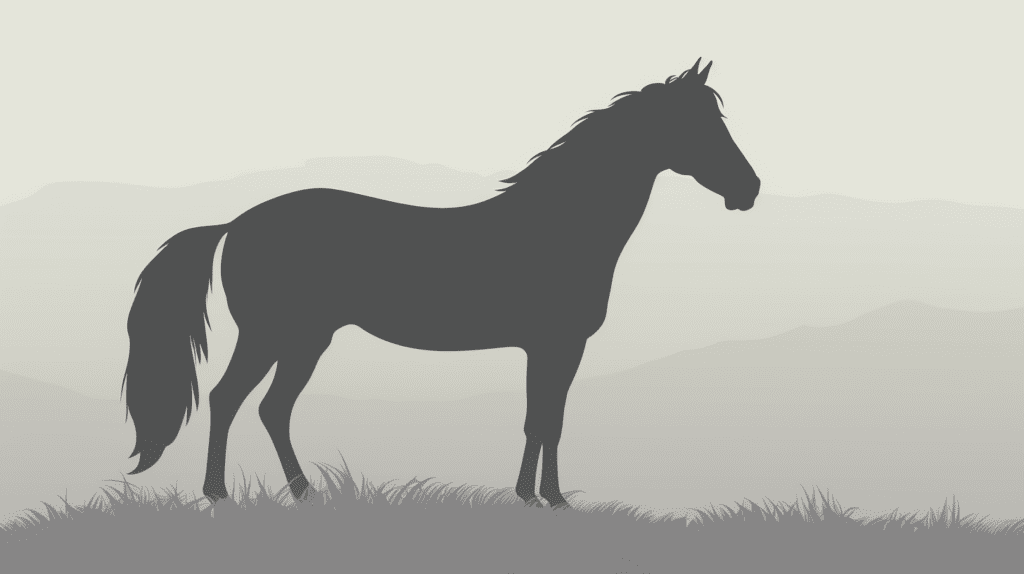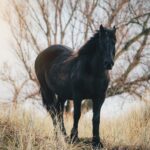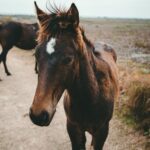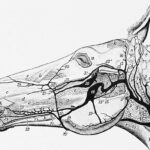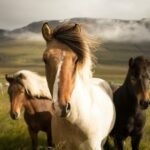An Ancient Breed Adapted to Harsh Mountains
The Altai horse is one of the oldest and hardiest breeds originating from the rugged Altai Mountains of Siberia. This ancient breed has a long history tied to the nomadic cultures of the region and is well-suited to survive and thrive in extremely harsh conditions.
With its compact yet sturdy build, sure-footed agility, and calm temperament, the Altai horse remains integral to the indigenous peoples of its native land to this day.
Physical Characteristics of the Altai Horse
The Altai breed stands out for its unique physical characteristics that enable it to be resilient and versatile. Here are some of the key traits of this hardy horse:
Size: Altai horses are moderate in size, averaging 13 to 13.3 hands tall (about 4’3″ to 4’7″ at the withers).
Head: These horses have a large, coarse head with a slightly dished profile and small eyes.
Neck: The neck is relatively short and fleshy.
Back: Altais have a long, muscular back that may be slightly dipped.
Barrel: The breed has a deep, rounded barrel.
Croup: The croup is well-developed and muscular.
Legs: Legs are short and strong with sturdy joints and hard hooves.
Colors: Common coat colors include chestnut, bay, black, and gray. Leopard spotting may sometimes occur.
This compressed yet muscular build allows the Altai horse to be agile and sure-footed over rocky and uneven ground. Their physical characteristics reflect generations of selective breeding to produce a hardy mountain horse.
History and Origins of the Altai Breed
The Altai horse originated in the Altai Mountains of Central Asia, a rugged region that spans across parts of Mongolia, China, Russia, and Kazakhstan.
This breed likely has ancient origins, as wild horses have existed in the region for millennia. Various nomadic peoples, including the Scythians, Huns, Mongols, and Turkic tribes, domesticated horses in the Altai Mountains as early as 3000 BCE.
Over centuries and millennia of selective breeding, these tribes developed the hardy Altai horse. The breed was highly valued for its endurance, surefootedness, and ability to survive in harsh conditions while carrying riders and cargo over mountainous terrain.
Due to their remote habitat, the Altai breed was relatively isolated. Their bloodlines remained fairly pure up through the early 20th century. Pressure for heavier work horses led to some crossbreeding with Russian and Lithuanian draft breeds in the late 19th and early 20th centuries. However, many Altai herds retained pure bloodlines as well.
Today, the Altai remains closely tied to the indigenous peoples of the Altai Mountain region. It continues serving as an all-purpose riding and work horse able to traverse rugged landscapes. These horses retain almost primal toughness thanks to the harsh mountain climate in which the breed evolved.
Characteristics and Temperament
In addition to their physical adaptations to mountainous terrain, Altai horses have a calm and trainable disposition. They are intelligent, willing workers renowned for their stamina.
Some key traits of the Altai breed include:
- Surefooted – The Altai horse has excellent balance and footing ability. This allows it to confidently cross steep, uneven, or slippery ground.
- Hardy – Thanks to natural selection in an extreme climate, these horses are highly resilient. They have strong hooves, dense bones, and a sturdy constitution.
- Strong – The muscular build of the Altai makes them powerfully strong for their moderate size.
- Enduring – This breed has incredible stamina and can cover long distances even in challenging terrain.
- Intelligent – Altai horses are responsive, trainable, and have good judgement. This makes them ideal for riding and work.
- Calm – They have a steady, unflappable temperament. Altais are sensible, reliable, and not easily spooked.
The Altai is renowned for its dependability and versatility thanks to this mix of strength, stamina, and sound disposition.
Traditional Uses of the Altai Horse
For the indigenous peoples of the Altai Mountains, this horse breed has been a crucial resource for thousands of years. Traditionally, Altai horses were essential for:
- Transportation – Providing mounts for riding and hauling cargo through the mountains. Their surefootedness was invaluable.
- Herding – Altais were used to herd and manage livestock like sheep, goats, yaks, and cattle.
- Hunting – Their athleticism and stamina allowed Altai horses to accompany hunters pursuing game across difficult terrain.
- Food – Mare’s milk was an important food source. Horses also provided meat when necessary.
- Hides and Hair – Horse hides were used for leather and insulation. Their hair could be woven into ropes and fabrics.
Even today, many herders in the Altai Mountains rely on this breed for riding, herding, and hauling loads. The Altai remains the horse of choice for navigating this challenging environment.
Current Status and Uses
The Altai breed remains relatively pure thanks to continued breeding of distinct bloodlines by indigenous peoples. However, the population numbers are vulnerable. In the early 2000s, the total Altai horse population was estimated to be around 4,000.
Efforts are underway to protect unique Altai sub-types through conservation initiatives in Mongolia, Kazakhstan, Russia, and China. The Altai is listed as “threatened” on the Rare Breeds Canada conservation status rankings.
While the Altai is at risk, it continues playing an important role for the rural inhabitants of the Altai Mountain region today by:
- Providing essential transportation and work abilities
- Generating income through breed and sport horse sales
- Preserving an ancient lineage and genetic diversity
In modern times, their intelligence and athleticism also make Altais suitable for:
- Recreational trail and endurance riding
- Ranch work and cattle handling
- Trekking tourism
The Altai breed’s beauty, personality, and hardiness appeal to a growing number of equestrian enthusiasts around the world. Careful breeding programs will be important for protecting this ancient breed while making its strengths available to new audiences.
Key Facts About the Altai Horse
Place of Origin: Altai Mountains of Central Asia
Other Names: Alta’s Kaya Horse
Size: 13 – 13.3 hands; 650-800 lbs
Colors: Chestnut, bay, black, gray; occasionally leopard spotted
Temperament: Willing, calm, intelligent, trainable
Strengths: Surefooted, hardy, strong, athletic, enduring
Historical Uses: Transportation, herding, hunting, food source
Modern Uses: Ranch work, trail riding, trekking, conservation
The Unique Altai – An Ancient Mountain Treasure
The Altai horse has survived for thousands of years in one of the world’s harshest environments, developing traits that make it perfectly adapted to the mountains it calls home.
As one of the world’s oldest breeds, the Altai remains culturally and genetically unique. With proper management, it promises to continue providing its essential services to the indigenous peoples of the Altai region while also attracting enthusiasts who appreciate this breed’s beauty, endurance, and storied history.
